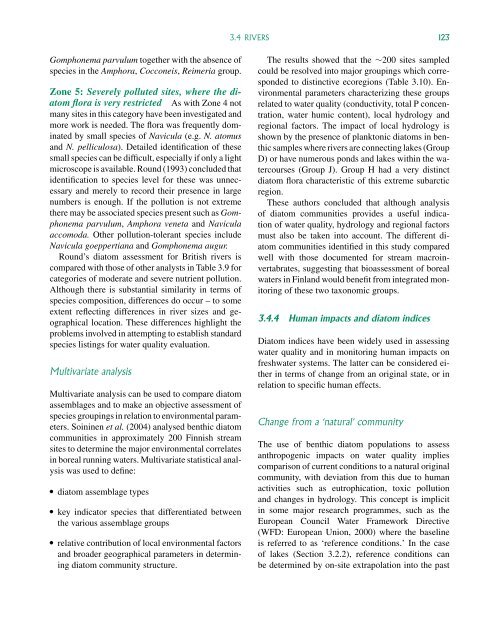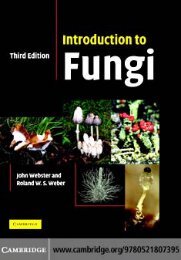Freshwater Algae: Identification and Use as Bioindicators
Freshwater Algae: Identification and Use as Bioindicators
Freshwater Algae: Identification and Use as Bioindicators
You also want an ePaper? Increase the reach of your titles
YUMPU automatically turns print PDFs into web optimized ePapers that Google loves.
3.4 RIVERS 123Gomphonema parvulum together with the absence ofspecies in the Amphora, Cocconeis, Reimeria group.Zone 5: Severely polluted sites, where the diatomflora is very restricted As with Zone 4 notmany sites in this category have been investigated <strong>and</strong>more work is needed. The flora w<strong>as</strong> frequently dominatedby small species of Navicula (e.g. N. atomus<strong>and</strong> N. pelliculosa). Detailed identification of thesesmall species can be difficult, especially if only a lightmicroscope is available. Round (1993) concluded thatidentification to species level for these w<strong>as</strong> unnecessary<strong>and</strong> merely to record their presence in largenumbers is enough. If the pollution is not extremethere may be <strong>as</strong>sociated species present such <strong>as</strong> Gomphonemaparvulum, Amphora veneta <strong>and</strong> Naviculaaccomoda. Other pollution-tolerant species includeNavicula goeppertiana <strong>and</strong> Gomphonema augur.Round’s diatom <strong>as</strong>sessment for British rivers iscompared with those of other analysts in Table 3.9 forcategories of moderate <strong>and</strong> severe nutrient pollution.Although there is substantial similarity in terms ofspecies composition, differences do occur – to someextent reflecting differences in river sizes <strong>and</strong> geographicallocation. These differences highlight theproblems involved in attempting to establish st<strong>and</strong>ardspecies listings for water quality evaluation.Multivariate analysisMultivariate analysis can be used to compare diatom<strong>as</strong>semblages <strong>and</strong> to make an objective <strong>as</strong>sessment ofspecies groupings in relation to environmental parameters.Soininen et al. (2004) analysed benthic diatomcommunities in approximately 200 Finnish streamsites to determine the major environmental correlatesin boreal running waters. Multivariate statistical analysisw<strong>as</strong> used to define: diatom <strong>as</strong>semblage types key indicator species that differentiated betweenthe various <strong>as</strong>semblage groups relative contribution of local environmental factors<strong>and</strong> broader geographical parameters in determiningdiatom community structure.The results showed that the ∼200 sites sampledcould be resolved into major groupings which correspondedto distinctive ecoregions (Table 3.10). Environmentalparameters characterizing these groupsrelated to water quality (conductivity, total P concentration,water humic content), local hydrology <strong>and</strong>regional factors. The impact of local hydrology isshown by the presence of planktonic diatoms in benthicsamples where rivers are connecting lakes (GroupD) or have numerous ponds <strong>and</strong> lakes within the watercourses(Group J). Group H had a very distinctdiatom flora characteristic of this extreme subarcticregion.These authors concluded that although analysisof diatom communities provides a useful indicationof water quality, hydrology <strong>and</strong> regional factorsmust also be taken into account. The different diatomcommunities identified in this study comparedwell with those documented for stream macroinvertabrates,suggesting that bio<strong>as</strong>sessment of borealwaters in Finl<strong>and</strong> would benefit from integrated monitoringof these two taxonomic groups.3.4.4 Human impacts <strong>and</strong> diatom indicesDiatom indices have been widely used in <strong>as</strong>sessingwater quality <strong>and</strong> in monitoring human impacts onfreshwater systems. The latter can be considered eitherin terms of change from an original state, or inrelation to specific human effects.Change from a ‘natural’ communityThe use of benthic diatom populations to <strong>as</strong>sessanthropogenic impacts on water quality impliescomparison of current conditions to a natural originalcommunity, with deviation from this due to humanactivities such <strong>as</strong> eutrophication, toxic pollution<strong>and</strong> changes in hydrology. This concept is implicitin some major research programmes, such <strong>as</strong> theEuropean Council Water Framework Directive(WFD: European Union, 2000) where the b<strong>as</strong>elineis referred to <strong>as</strong> ‘reference conditions.’ In the c<strong>as</strong>eof lakes (Section 3.2.2), reference conditions canbe determined by on-site extrapolation into the p<strong>as</strong>t
















